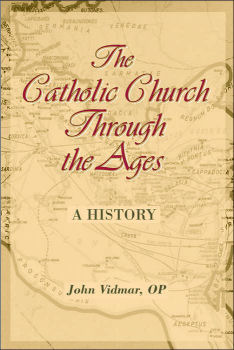
|
Posted October 12, 2005
Book: The Catholic Church Through the Ages: A History Author: John Vidmar, OP Paulist Press, NY, pp. 360 An Excerpt from the Jacket:
An Excerpt from the Book: John Paul II and Beyond There is no question that the last pope of the twentieth century and the first of the twenty-first has had a huge impact on the church. He produced three revolutions: in the communist world, in his program of canonization, and in his travels. In the communist world, his ties to the labor union, Solidarity, and his immense influence on the east definitely helped to topple the communist empire. There is a history yet to be written about his special relationship with President Ronald Reagan in this endeavor. He also brought about a revolution over how saints are canonized, not only streamlining the saint-making process, but introducing a new category of saints (martyrs for charity), and updating the list of saints, making them more relevant. Between 1234 and 1983, fewer than 300 saints had been canonized. In 1988 alone, John Paul canonized 124, 114 of whom were the Martyrs of Vietnam. By October 2002, he had canonized 464 saints, and would beatify Mother Teresa of Calcutta a year later. His traveling and connecting with different parts of the world is unprecedented among popes. The immense gatherings of the Catholic faithful everywhere he has gone – with special mention of his Mass on the Mall in Washington D.C., his trips to the Philippines and Mexico, which drew crowds the size of which no one in history has been able to bring together, and his final trip to Poland, not to mention his particular attention to World Youth Days and the outpouring of support shown on all his visits – will no doubt endear him in memory of the world for years, if not centuries, to come. This was an extraordinary pope and one recognized by the unprecedented international outpouring of feeling at his funeral in April 2005. His successor, Joseph Ratzinger, took the name Benedict XVI, undoubtedly as a tribute to the little-known but highly effective Benedict XV (1914-1922), who was known as the Pope of the Missions.” He inherits a Church that is truly worldwide, facing new challenges with the confidence of its durability through the ages. The End of the Sixth Age If Christopher Dawson’s theory of Six Ages of the Church is correct, two conclusions might be drawn. One is that we do not know when, exactly, this Sixth Age is going to end. Past experience would suggest taht we have another hundred years to go. The second conclusion is that , no matter when or who it ends, the church will somehow survive and develop. Horace Walpole, in 1769, wanted to go to Rome to witness, as he wrote to a friend, “the election of the last pope.: In looking over the ups and downs of the church from its beginning, one thing should be very clear: The church will emerge active and challenging to a new world. We could not do better than cite the twentieth-century English writier G. K. Chesterton, who noted that, in all the centuries of the church’s life, and all of the predictions that the church was going to the dogs, “it was always the dog that died.” Table of Contents: I. The First Age of the Church (30-330 AD) — The Early Church II. The Second Age of the Church (330-650 AD) – The Age of the Fathers III. The Third Age of the Church (650-1000 AD) – The Dark Ages IV. The Fourth Age of the Church (1000-1450 AD) – The Middle Ages V. The Fifth Age of the Church )1450-1789) – Protestant and Catholic Reformations VI. The Sixth Age of the Church (1789-Present) – The Modern Age |
|
